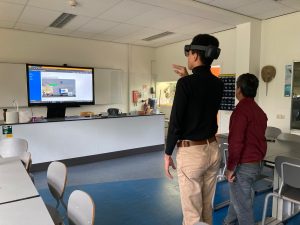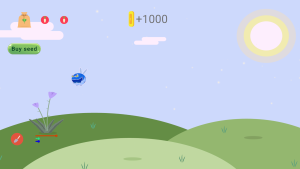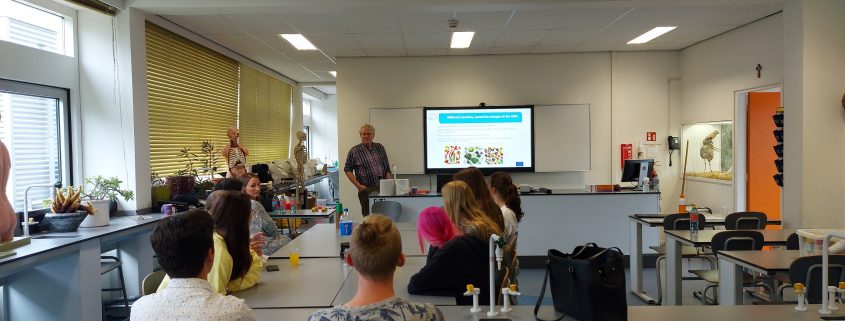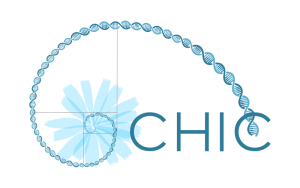CHIC Partners Visit 2 Secondary Schools in the Netherlands to Showcase AR Game
 An augmented reality (AR) game was developed for the CHIC project to allow students, or the young generation, to learn more about new genome editing techniques and, of course, learn more about the CHIC project. Developed by DEI Lab at UC3M in Spain, MyCHICFarm allows users to grow chicory crops and make the most money by planting chicory using Microsoft’s Hololens. In short, a farmer (user) starts with a fixed amount of money to buy chicory seeds, plant them, grow them, collect them, and then sell them in the market. Based on the quality of crops, the price change. It is also affected by unexpected events such as droughts, rain, and insects, for example. The game also includes a way to utilize CRISPR/Cas technique on plant DNA.
An augmented reality (AR) game was developed for the CHIC project to allow students, or the young generation, to learn more about new genome editing techniques and, of course, learn more about the CHIC project. Developed by DEI Lab at UC3M in Spain, MyCHICFarm allows users to grow chicory crops and make the most money by planting chicory using Microsoft’s Hololens. In short, a farmer (user) starts with a fixed amount of money to buy chicory seeds, plant them, grow them, collect them, and then sell them in the market. Based on the quality of crops, the price change. It is also affected by unexpected events such as droughts, rain, and insects, for example. The game also includes a way to utilize CRISPR/Cas technique on plant DNA.
After several months of development and various changes, the augmented reality game is finally available for trial. In September 2021, CHIC partners from WUR and IDC visited 2 schools in The Netherlands, Laar & Berg in Laren and Sg Spieringshoek in Schiedam. CHIC showcased the MyCHICFarm augmented reality game to secondary students and allowed them to check the game out for themselves. The demonstration was also a way to teach them about CRISPR/Cas technique and about the CHIC project. All participating students volunteered to join the demonstration and a few of those students also participated in the 1-hour discussion in the afternoon. The sessions and the discussions were mostly presented in Dutch due to the schools being located in The Netherlands.
The format was as followed: CHIC introduced themselves, presented videos about CRISPR and a video illustration about the CHIC project, introduced the AR game, and allowed 1 student at a time to try out the game. At the same time, CHIC partners talked to the rest of the students about the CRISPR/Cas technique and the project. The game was projected on a big screen, so everyone was able to view what the user was looking at, which allowed for a very fun and engaging session. It created very engaging interactions and inspired more students to participate.


 An android game app, developed by the same university, was also available for download. The game is available for download on Google play or a link through the CHIC website: https://chicproject.eu/chic-game-app/. In the future, the game should also be available on iPhones. Some students checked out the game while they waited for their turn on Microsoft Hololens. The game app was quite similar to the AR game and was relatively simple to follow, which engaged the students as well. Further changes might be needed to further optimize its use by adding more functions such as more CRISPR type of activities. So far, the game has been installed 11 times and currently, there are 5 active users.
An android game app, developed by the same university, was also available for download. The game is available for download on Google play or a link through the CHIC website: https://chicproject.eu/chic-game-app/. In the future, the game should also be available on iPhones. Some students checked out the game while they waited for their turn on Microsoft Hololens. The game app was quite similar to the AR game and was relatively simple to follow, which engaged the students as well. Further changes might be needed to further optimize its use by adding more functions such as more CRISPR type of activities. So far, the game has been installed 11 times and currently, there are 5 active users.
Participating students, who have signed voluntarily, were mainly part of high-level classes, pre-university classes, and some from community college classes. All students have basic knowledge about DNA and its functions, and they also have some knowledge about different GMO techniques and in particular CRISPR/Cas. For the majority of the students, DNA and DNA modification techniques are part of their biology curriculum.
 Majority of the questions that were asked and discussed during the demonstration were about the advantages and disadvantages of using the CRISPR technique on plants. Most students asked about the importance of using this technique and how useful this will be in the future. CHIC partners also asked the students if they would support the idea of using the technique on future plants for environmental purposes. All students were aware that the researchers and scientists were mainly focused on discussing plant editing techniques and not on human DNAs.
Majority of the questions that were asked and discussed during the demonstration were about the advantages and disadvantages of using the CRISPR technique on plants. Most students asked about the importance of using this technique and how useful this will be in the future. CHIC partners also asked the students if they would support the idea of using the technique on future plants for environmental purposes. All students were aware that the researchers and scientists were mainly focused on discussing plant editing techniques and not on human DNAs.
Overall, the students from both schools had an amazing time. Students were very engaged in the game and the discussions that CHIC partners presented. They allowed the students to speak their minds about the subject, which made for very lively discussions. It was great to gather insights from the young generation about the possible benefits of using this technique.


 This project has received funding from the EU Horizon 2020 research & innovation programme under grant agreement N. 760891.
This project has received funding from the EU Horizon 2020 research & innovation programme under grant agreement N. 760891.

